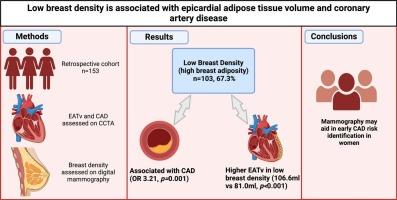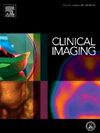Low breast density is associated with epicardial adipose tissue volume and coronary artery disease
IF 1.8
4区 医学
Q3 RADIOLOGY, NUCLEAR MEDICINE & MEDICAL IMAGING
引用次数: 0
Abstract
Purpose
Epicardial adipose tissue volume (EATv), is well correlated with coronary artery disease (CAD), however not reported clinically. Breast density, measured on mammography, has shown promise as a reflector of cardiometabolic risk, with less dense breasts indicating greater proportion of adipose tissue. We aimed to evaluate the association between breast density, EATv and CAD.
Method
Retrospective, cross-sectional study including 153 women who had both clinically indicated coronary computed tomography angiogram (CCTA) and mammography. EATv was quantified using semi-automated software. Breast density was visually assessed by standard 4-level BI-RADS grading (low: BI-RADS A–B, high: BI-RADS C![]() D). CAD was categorised as presence/absence of coronary artery plaque and severity was quantified using CAD-RADS score.
D). CAD was categorised as presence/absence of coronary artery plaque and severity was quantified using CAD-RADS score.
Results
Among 153 patients (mean age 62 ± 10), 103 (67.3 %) had low breast density (high breast adiposity). Low breast density patients were older, had greater rates of hypertension, higher mean BMI (p < 0.001) and EATv (106.6 ± 43.0 ml vs 81.0 ± 31.6 ml, p < 0.001). EATv was predictive of low breast density (OR: 1.02[1.01–1.03], p = 0.006), independent of age and hypertension. Low breast density was strongly associated with presence of CAD (prevalence 75 % vs 48 %, OR: 3.21[1.58–6.53], p = 0.001) independent of EATv, and modifiable (OR: 2.69[1.24–5.92], p = 0.012) and non-modifiable (OR: 2.42[1.04–5.85], p = 0.047) cardiovascular risk factors. Low breast density made up a higher proportion of mild (76.5 %), moderate (73.9 %) and severe (80.0 %) CAD.
Conclusions
Low breast density is associated with higher EATv and independently associated with CAD presence beyond EATv and other cardiovascular risk factors. Mammographic breast density may therefore have value as an early risk identification tool for CAD in women.

低乳房密度与心外膜脂肪组织体积和冠状动脉疾病有关。
目的:心外膜脂肪组织体积(EATv)与冠状动脉疾病(CAD)有很好的相关性,但没有临床报道。通过乳房 X 射线照相术测量的乳房密度有望反映心脏代谢风险,密度较低的乳房表明脂肪组织的比例较高。我们的目的是评估乳房密度、EATv 和 CAD 之间的关联:方法:回顾性横断面研究,包括 153 名接受过临床指征冠状动脉计算机断层扫描(CCTA)和乳房 X 射线照相术的女性。使用半自动软件对 EATv 进行量化。乳腺密度通过标准的四级 BI-RADS 分级(低:BI-RADS A-B,高:BI-RADS CD)进行目测评估。冠状动脉粥样硬化分为有/无冠状动脉斑块,严重程度用 CAD-RADS 评分量化:在 153 名患者(平均年龄 62 ± 10 岁)中,103 人(67.3%)乳房密度低(乳房脂肪含量高)。低乳腺密度患者年龄更大,高血压发病率更高,平均体重指数(BMI)更高(P 结论:低乳腺密度与更高的 EEG 相关:低乳房密度与较高的 EATv 有关,并且与 CAD 的存在有独立的关联,超出了 EATv 和其他心血管风险因素。因此,乳腺X线照相术中的乳腺密度可作为早期识别女性患 CAD 风险的工具。
本文章由计算机程序翻译,如有差异,请以英文原文为准。
求助全文
约1分钟内获得全文
求助全文
来源期刊

Clinical Imaging
医学-核医学
CiteScore
4.60
自引率
0.00%
发文量
265
审稿时长
35 days
期刊介绍:
The mission of Clinical Imaging is to publish, in a timely manner, the very best radiology research from the United States and around the world with special attention to the impact of medical imaging on patient care. The journal''s publications cover all imaging modalities, radiology issues related to patients, policy and practice improvements, and clinically-oriented imaging physics and informatics. The journal is a valuable resource for practicing radiologists, radiologists-in-training and other clinicians with an interest in imaging. Papers are carefully peer-reviewed and selected by our experienced subject editors who are leading experts spanning the range of imaging sub-specialties, which include:
-Body Imaging-
Breast Imaging-
Cardiothoracic Imaging-
Imaging Physics and Informatics-
Molecular Imaging and Nuclear Medicine-
Musculoskeletal and Emergency Imaging-
Neuroradiology-
Practice, Policy & Education-
Pediatric Imaging-
Vascular and Interventional Radiology
 求助内容:
求助内容: 应助结果提醒方式:
应助结果提醒方式:


